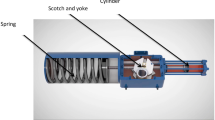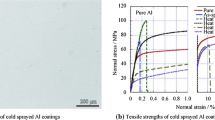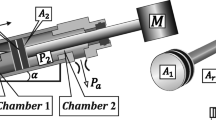Abstract
The magnetostrictive actuator, with its unique characteristics such as high force, stiffness, large strain is potentially a new class actuator application such as fast tool servo, vibration control applications. but the performance of magnetostrictive actuator is highly dependent on preload, magnetic field intensity and thermal expansion. this paper presents the development of a magnetostrictive actuator and an experimental and analytical investigation of the temperature effect on the displacement characteristics of the developed magnetostrictive actuator. when the current applied to the excitation coil to supply the magnetic field to the magnetostrictive material, heat which effects thermal expansion is produced. precision position control of magnetostrictive actuator is difficult caused by thermal strain. therefore, magnetostrictive actuator is need of cooling system. in this paper, the development of a magnetostrictive actuator with built-in air cooling system which use compressed cold air and proper temperature and velocity of compressed cold air was studied by thermal analysis. simulation results were verified by experiment, tracking performance improvement was achieved by eliminating thermal expansion.
Similar content being viewed by others
References
Jenner, A., Smith, G. and Wilkinson, A. J., “Actuation and transduction by giant magnetostrictive alloys,” Mechatronics, Vol. 10, No. 4–5, pp. 457–466, 2000.
Claeyssen, F., Lhermet, N. and Bouchilloux, P., “Actuators, transducers and motors based on giant magnetostrictive materials,” Journal of Alloys and Compounds, Vol. 258, No. 1–2, pp. 61–73, 2001.
Grunwald, A. and Olabi, A. G., “Design of a magnetostrictive actuator,” Sensor and Actuator, Vol. 144, No. 1, pp. 161–175, 2008.
Goodfriend, M. J. and Shoop, K. M., “High force, high strain, wide bandwidth linear actuator using the material, Terfenol-D,” Proc. of the conference on recent advances in active control of sound and vibration, pp. 301–312, 1991.
Moon, S. J., Lim, C. W., Kim, B. H. and Park, Y. J., “Structural vibration control using linear magnetostrictive actuators,” Journal of Sound and Vibration, Vol. 302, No. 4–5, pp. 875–891, 2007.
Janocha, H., “Application potential of magnetic field driven new actuator,” Sensors and Actuator A, Vol. 91, No. 1–2, pp. 126–132, 2001.
Bartlett, P. A., Eaton, S. J., Gore, J., Metheringham, W. J. and Jenner, A. G., “High-power, low frequency magnetostrictive actuation for anti-vibration applications,” Sensor and Actuators A, Vol. 91, No. 1–2, pp. 133–136, 2001.
Jia, Z., Liu, H. and Wang, F., “Researches on the computer digital control system of giant magnetostrictive actuator,” Mechatronics, Vol. 19, No. 7, pp. 1191–1196, 2009.
Anjanappa, M. and Bi, J., “A theoretical and experimental study of magnetostrictive mini-actuators,” Smart Material, Vol. 3, No. 2, pp. 83–91, 1994.
Etrema Products Inc., http://www.etrema.com/products/terfenol
Eiamsa, S. and Promvonge, P., “Numerical investigation of the thermal separation in a Ranque-Hilsch vortex tube,” International Journal of Heat and Mass Transfer, Vol. 50, No. 5–6, pp. 821–832, 2007.
Liu, J. and Chou, Y. K., “On temperatures and tool wear in machining hypereutectic Al-Si alloys with vortex-tube cooling,” International Journal of Machine Tools and Manufacture, Vol. 47, No. 3–4, pp. 635–645, 2007.
Bae, J. H., Kim, M. S., Hwang, B. C. and Kim, C., “Development of an apparatus for removing magnetic sludge by permanent magnets setup in the condenser of the power plant,” Int. J. Precis. Eng. Manuf., Vol. 11, No. 2, pp. 299–309, 2010.
Author information
Authors and Affiliations
Corresponding author
Rights and permissions
About this article
Cite this article
Kwak, YK., Kim, SH. & Ahn, JH. Improvement of positioning accuracy of magnetostrictive actuator by means of built-in air cooling and temperature control. Int. J. Precis. Eng. Manuf. 12, 829–834 (2011). https://doi.org/10.1007/s12541-011-0110-z
Received:
Accepted:
Published:
Issue Date:
DOI: https://doi.org/10.1007/s12541-011-0110-z




